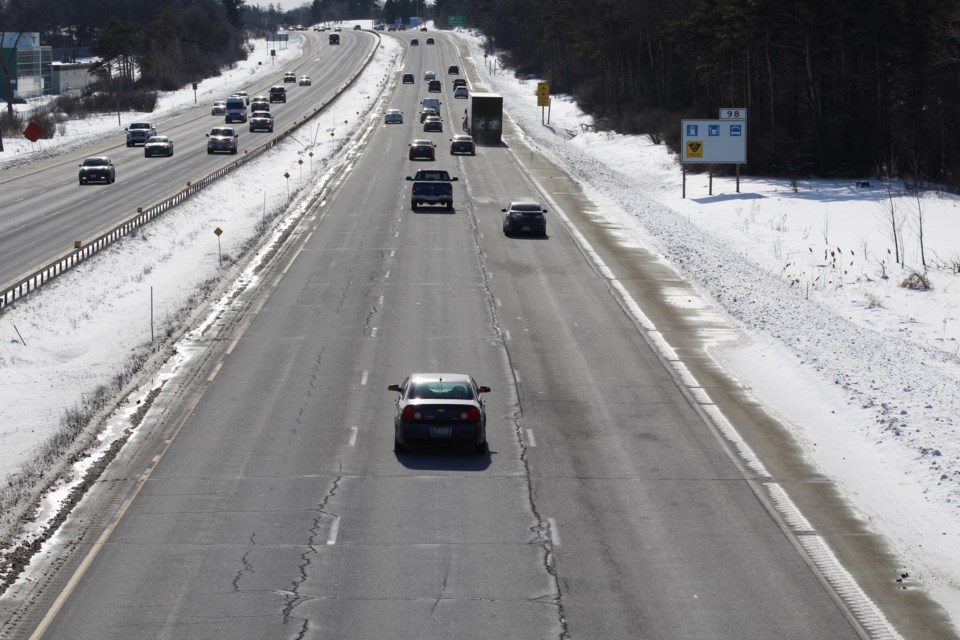If you've driven on Highway 400 from Toronto with any regularity, you've probably encountered a sea of brake lights somewhere around Essa Road while heading northbound.
You expect to roll past a crash scene at any moment as the reason behind the delay, only to get to the northern limit of the city and realize it was just congestion, plain and simple. It happens quite often but is even more pronounced in the summer months.
That problem could be alleviated in the coming years.
More bulldozers and earth movers are coming soon to Highway 400, which runs like a ribbon through Barrie, and a lot more construction is expected to ramp up.
There are plans to eventually expand the highway to accommodate up to 10 lanes of traffic through Barrie, but only the first phase of design has been completed.
"The widening of Highway 400 through Barrie was included in the Environmental Assessment (EA) for Highway 400 from one kilometre south of Highway 89 to Highway 11, which received environmental clearance in late 2017," Chris Singh, the MTO's acting senior issues advisor, tells BarrieToday.
"Conducting the EA clarifies the property requirements for future freeway expansion and allows development in the vicinity of the freeway highway to proceed with greater certainty," Singh says.
Exactly how much Highway 400 widening could cost won't be known until the detailed design phase, which is the next step.
However, there's also currently no funding set aside for Highway 400 widening through Barrie and the provincial government is currently reviewing all projects.
"No further design work directly related to highway widening will take place until funding is committed," Singh says. "There may be some indirect design work related to bridge rehabilitation/replacement projects as these need to account for and accommodate future widening."
In the meantime, there are several "anticipated" rehabilitation projects along Highway 400, Singh says, including replacement of the Anne Street, Sunnidale Road, Dunlop Street, and Essa Road bridges, as well as interchange reconstruction at Dunlop and Essa. The bridge replacements will accommodate future widening of Highway 400.
"This work is anticipated to be spread out between 2020 and 2027," Singh says.
The old Tiffin Street bridge has also been undergoing demolition and replacement recently.
Although the MTO is leading these projects, the city is a "key stakeholder," says Stew Patterson, the City of Barrie's manager of construction.
"As an example, the city is required to relocate municipal infrastructure that is located within MTO’s right-of-way in order to facilitate the ultimate construction," he says. "Staff from MTO and the city are in regular contact to ensure the timing of the various improvements proceeds in a logical fashion."
The two levels of government are working together to make the work as smooth as possible.
"The city and MTO are working collaboratively to incorporate transportation improvements that support the needs of both local residents and the travelling public at large," Patterson says. "These improvements will enhance the transportation network and help mitigate traffic congestion."
There's also the Harvie Road bridge over Highway 400 connecting to Big Bay Point Road, which will stretch 90 metres, with a centre median pier. Its design also takes into account future highway widening for up to 10 lanes.
Utility relocation is continuing through the winter for the Harvie Road bridge, with Alectra (electricity) and Bell relocations ongoing and Zayo and Rogers telecommunications work to come, Patterson says. Culvert installation under Highway 400 is already underway.
"Bridge construction and road construction will ramp up once utility relocations are completed," he says.
Farther south, the city is leading the way on an interchange at McKay Road, which is located between Innisfil Beach Road and Mapleview Drive at the municipality's southern limit.
"New interchanges on existing freeways, such as at McKay Road, are typically considered municipal infrastructure as they are proposed for the purpose of improving the flow of traffic on the municipal road network," Singh says.
However, because Essa Road is an existing interchange, Singh says the decision on who leads and pays for reconstruction typically depends on the purpose of the reconstruction.
"Often, because there are specific needs by both the province and local municipality, there is cost sharing on freeway crossings and/or interchange reconstruction," Singh says.
The ministry has initiated a detail design assignment for the Essa Road interchange driven by the need to replace, rather than rehabilitate, the bridge due to the structural life-cycle considerations, Singh notes.
"Since the bridge is being replaced, it makes economic sense to replace the bridge that will accommodate the future widening of Highway 400 to 10 lanes, since the widening, although not yet funded, will take place during the 75-year life cycle of the new bridge," he says.
In the near future, the reconstructed Essa Road interchange will tie into a six-lane Highway 400 cross-section, but will be designed to connect to a future 10-lane cross section with minimum reconstruction required at that time, Singh notes.
When asked whether there could be any concerns with Highway 400 expansion through the city, Singh says that's always a possibility.
"There are always technical challenges with major highway widening projects," he says. "Often, these technical challenges aren’t apparent until the project is in detail design phase and typically can be resolved with engineering solutions."
